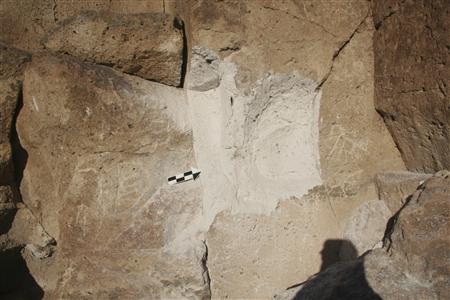
Four petroglyphs carved into volcanic rock more than 3,500 years ago have been hacked out and stolen by thieves who also damaged other engravings at a historic site in California, U.S. authorities said on Tuesday.
The petroglyphs in the Volcanic Tablelands east of Yosemite represented a "pristine example of Great Basin rock art" that portrayed the daily hunter-gatherer activities that took place in the area, the Bureau of Land Management said.
"The individuals who did this have destroyed an irreplaceable part of our national cultural heritage," Bernadette Lovato, Bureau of Land Management field office manager, said in a statement.
"We have increased surveillance of our sites and are working with other agencies to bring the responsible parties to justice and to recover the petroglyphs," Lovato said.
It was not immediately clear when the petroglyphs, or rock engravings, were removed from the site near California's border with Nevada. A volunteer monitor first spotted the damage on October 31, bureau spokesman David Christy said.
"This is terrible. This place is on the National Register of Historic Places," Christy told Reuters. "Among the rock art community, it's known as one of the outstanding examples of rock art."
Christy said the thieves would have needed ladders, concrete cutting saws and power generators to cut out the petroglyphs - not a fast or easy job.
"This wasn't casual, somebody walking around picking up arrowheads. This was a serious effort," he said.
No suspects have been identified so far. Christy said the petroglyphs had not yet surfaced on the black market for stolen antiquities.
The Volcanic Tablelands are described by the Bureau of Land Management as a vast volcanic landscape formed more than 700,000 years ago by materials spewing from the Long Valley caldera to the northwest.
The high-desert site and its volcanic rock outcroppings are listed in the National Register of Historic Places, protected under the Archaeological Resources Protection Act and still used by local Paiute Indians for ceremonies.
"The location of archaeological materials, feature remains and the rock art clearly portray the activities that occurred at the site during the last 3,500 years," Greg Haverstock, an archaeologist for the Bureau of Land Management's field office in Bishop, California, said in a statement.
The Bureau of Land Management has offered a $1,000 reward for information leading to the arrest and conviction of the people responsible for the theft.
According to the Bureau of Land Management, first-time violators of the Archaeological Resources Protection Act can be imprisoned up to one year and fined $20,000.

No comments:
Post a Comment